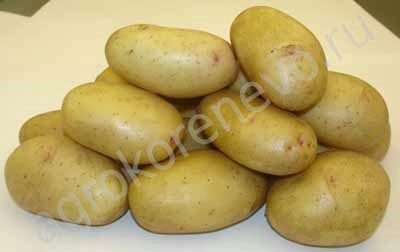
- Authors: Yashina Izolda Maksimovna, Simakov Evgeny Alekseevich, Mityushkin Aleksey Vladimirovich, Salyukov Sergey Sergeevich, Zhuravlev Aleksey Alekseevich
- Year of approval: 2013
- Appointment: table, suitable for the production of starch, for the production of puree
- Tuber weight, g: 104-143
- Peel color: light beige
- Color of the pulp: cream
- Starch content,%: 15,9-18,9%
- Tuber shape: oval-rounded
- Peel structure: smooth
- Flowers: Corolla small to medium in size, strong anthocyanin coloration on the inside
For growing in a garden or summer cottage, as a rule, universal-purpose potato varieties are chosen, which are well stored in the cellar. It is also important that the culture is unpretentious and quickly adapts to the climatic characteristics of the region. These are the characteristics that the Giant table potato variety is endowed with.
Breeding history
The giant is one of the achievements of domestic scientists of the All-Russian Research Institute of Potato Farming named after V.I. A.G. Lorkha. The authorship belongs to a group of breeders - Yashina I.M., Matyushkin A.V., Zhuravlev A.A. and Salyukov S.S.The following parental forms were used for breeding: hybrid 946-3 and Effect. The nightshade crop appeared in the State Register of Breeding Achievements of the Russian Federation in 2013. Recommended for growing potatoes in three regions of Russia - Central, Volgo-Vyatka and Central Black Earth.
Description of the variety
The giant is a tall, powerful bushes of an intermediate type. Each bush is characterized by not very strong spreading of branches, moderate foliage with dark green leaves and semi-erect stems. It is also worth highlighting the developed root system, thanks to which from 8 to 13 large root crops ripen in each bush.
Potato bushes begin to bloom in the second half of June. The flowering period of the bushes is short. At this time, medium-sized red-purple flowers appear, which quickly fall off.
Characteristics of the appearance of the bush and root crops
The variety is large-fruited. The tubers have a regular, oval-round shape with a smooth and shiny surface. On average, root crops weighing 104-143 g ripen on a bush, sometimes the weight reaches 150 grams. The peel of vegetables is thin, almost transparent, with a small number of reddish eyes, which are shallow. The color of potatoes is classic - light beige.
The dug out potatoes easily transfer transportation over long distances, and are also characterized by long keeping quality, the main thing is to observe the temperature regime and control the humidity level.
Purpose and taste of tubers
Giant potatoes are famous for their good taste and excellent presentation. The creamy pulp has a moderately dense, non-mealy, oily consistency, without wateriness. When cleaning and heat treatment, the color of the pulp does not change. When boiled, the potatoes crack a little, maintaining integrity and acquiring a pleasant taste. The pulp contains an increased amount of starch - almost 19%, due to which it is used in the preparation of starch, flour and freeze-dried puree.
The advantage of the variety is its universal purpose - potatoes are boiled in a peel and peeled whole, added to first courses, stewed, baked, fried, used in the preparation of salads, chips, frozen vegetable mixtures. It is also ideal for making French fries.
Maturation
The giant is a medium-ripening variety. The growing season lasts up to 115-120 days. The germination of sprouts is friendly. The first digging can be done in early August. Mass harvesting begins in mid-August.
Yield
The giant is a high-yielding variety.With proper agricultural technology and favorable weather conditions, up to 2 kg of large potatoes can be harvested from 1 bush. On average, up to 4.2 kg of tubers are dug from 1 m2 of plantings, and about 420 kg of root crops ripen on one hundred square meters. On an industrial scale, you can count on an average of 290-424 centners per hectare.
Growing and care
Potatoes are planted in early May, when the temperature regime is normal (+ 10 ... 12 degrees), and the soil is sufficiently warmed up to a depth of 10 cm. For planting, germinated tubers of the same medium size are selected. Landing is carried out according to the scheme 35x65 cm.
Cultural agrotechnics include: watering according to the condition of the soil, loosening and weeding, hilling (2-3 times per season), fertilizing (three times per period), disease prevention.

Planting potatoes is one of the main spring activities traditional for Russian gardeners. There are many ways to plant this vegetable, allowing you to get a good harvest in different conditions and climates. Before planting, you need to carefully prepare the planting material, correctly determine the timing, competently prepare the soil.


Soil requirements
The variety is able to grow in any soil, but the plant is most comfortable on sandy loam and light loam. The soil should be fertile, breathable, moist, well fluffed. It is important that there is no stagnation of moisture, which contributes to the development of some fungal infections. In addition, potatoes do not like acidic soils, so the soil should be neutral or low in acidity.

Required climatic conditions
The giant is a thermophilic, drought-resistant variety, but negatively perceives long-term shade. The site should be flat, abundantly illuminated by the sun, protected from drafts.
Disease and pest resistance
Thanks to their strong immunity, potatoes are quite resistant to a number of diseases - cancer, foliage twisting, late blight of leaves and tubers, black and common scab. The plant's only problem is the golden nematode.

Potatoes are a popular vegetable crop that many gardeners planted on their site. But growing a bountiful harvest of tasty and large tubers is unlikely to succeed if the beds are not properly protected from the most common diseases and pests. Often, the development of diseases of various etiologies of potatoes goes unnoticed, so it is important to identify the problem in time and eliminate it.
















































































